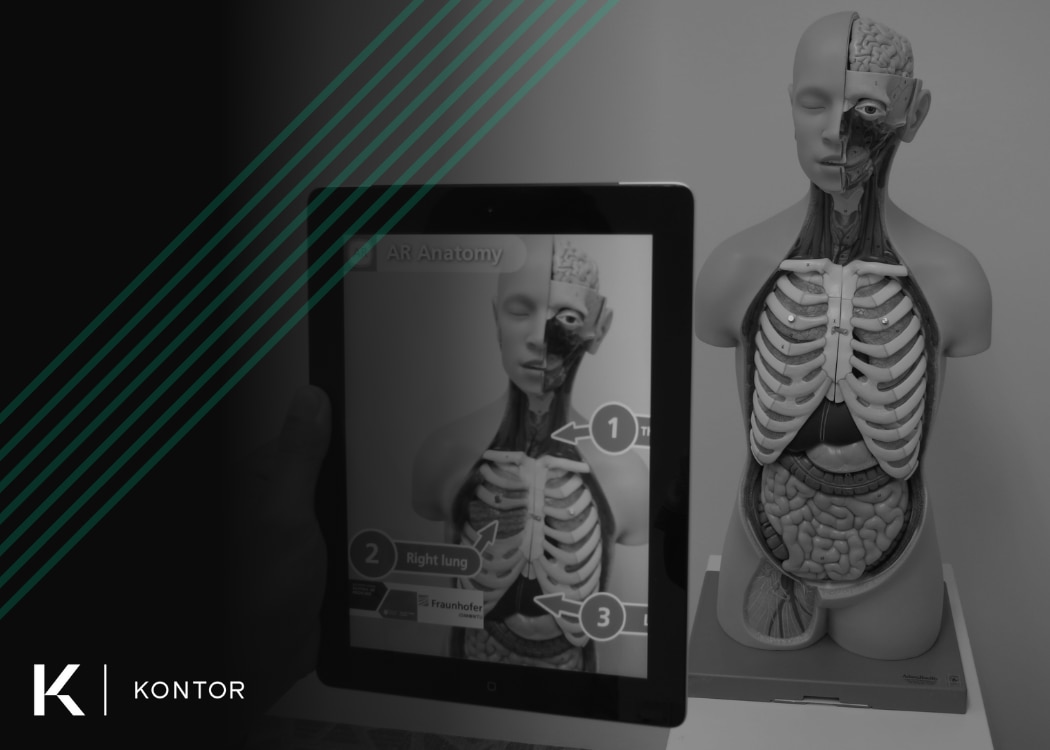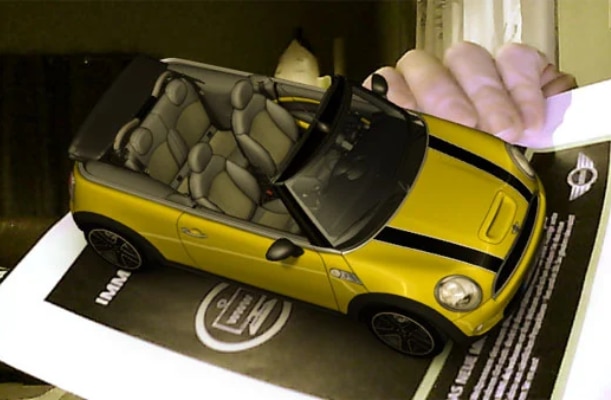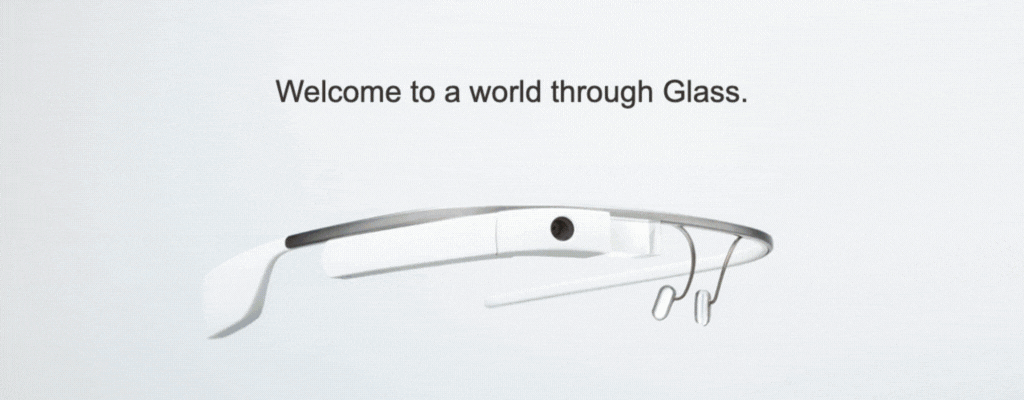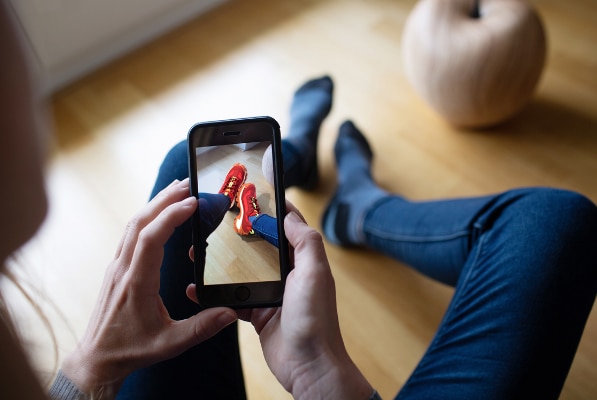What is augmented reality (AR)?

TL;DR: Augmented reality (AR) overlays digital content like 3D objects, text, directions, notifications, and images on top of real-world objects and is typically accessed via smart glasses, smartphones, tablets, wearables, and virtual reality (VR) headsets equipped with passthrough functionality.
— — — — —
Augmented reality (AR) is a swiftly growing immersive technology. AR applications are accessed through a head mounted display (HMD), like smart glasses, some virtual reality (VR) headsets, mobile devices, wearables, and more. Once an application is launched, digital content is overlayed atop of objects in the real world. For example, a user may choose to have walking directions displayed. They’ll be guided by directional arrows, displayed over the correct streets, and will find a pin at their destination. Or a parent may want to visualize how the toy they’d like to purchase for their child would look once it’s in their home.
The widespread adoption of AR is transforming both how we perceive and interact with the world around us. It’s a paradigm shift that brings opportunities, from enhancing everyday experiences to revolutionizing entire industries.
This blog covers augmented reality as a technology. We’ve already discussed what AR is in a previous blog — What’s the difference between virtual reality, augmented reality, and mixed reality? Here, we’ll go a bit deeper — a brief history, how it works, and common use cases across a variety of industries.
— — — — —
A brief history of augmented reality

AR’s inception can be traced back to 1968 with Ivan Sutherland’s invention of the first-ever head-mounted display (HMD) system. The device was called The Sword of Damocles, and when worn, users would see wire frames of shapes or rooms. As the user turned their head or moved around the object, their perspective of the object would change in relation.
However, it wasn’t until 1990 that Boeing researcher Tom Caudell coined the term ‘augmented reality.’ He envisioned a world where workers assembling Boeing 747 aircrafts could visualize how to install new parts using a secondary device.
In 2008, the first commercial AR application appeared, used by MINI to transform a flat, two-dimensional magazine advertisement to an interactive 3D ad with the assistance of a computer and web cam.
 Photo by Technabob | Technabob.com
Photo by Technabob | Technabob.com
Fast forward to May 2014 and the launch of the Google Glass. Referred to simply as “Glass,” the HMD looked like a pair of glasses, but with a small screen, camera lens, and battery consuming the right half. Though the project was commercially unsuccessful, many of the features have been adapted for modern smart glasses.
 Photos by Google | Google.com/Glass | Accessed via Archive.org
Photos by Google | Google.com/Glass | Accessed via Archive.org
Augmented reality as a concept has existed for decades. Dedicated AR products have only recently found their way into the hands of consumers at scale. As the hardware that powers AR devices gets smaller, faster, lighter, and less cost-prohibitive, we’ll see the technology integrate with products we already use (like smartphones), spaces previously abandoned (like glasses, but actually fashionable), and into new areas that we can’t yet fathom.
— — — — —
How AR works

Experiencing augmented reality requires a device, plain and simple. As images are projected, their precise positioning and orientation is calculated to produce an accurate display. This process is made possible using a combination of cameras and depth sensors to capture images and spatial data to perceive the physical environment. For some applications, GPS and location services are used to provide context about location and/or orientation.
The captured images undergo complex processing using advanced algorithms to be analyzed in real time. This process identifies objects, surfaces, and their positions in relation to the device with remarkable accuracy. This process is crucial for ensuring that the digital elements align perfectly with the physical world.
Finally, the content is displayed on the user’s device.
 Photo by Scanblue | Scanblue.com
Photo by Scanblue | Scanblue.com
But there isn’t just a single type of augmented reality—there are (at least) five. To better understand how AR works, it is important to understand each of these categories.
- Marker-based AR: Relies on visual markers to trigger an AR-based experience. Users trigger the experience using their smartphone’s camera to activate the 3D digital image on their screen.
- Markerless AR: Uses location-based data from mobile accelerometers or global positioning systems (GPS) from mobile devices to trigger AR content.
- Projection-based AR: This type of AR uses projectors to display digital content like 3D objects and holograms on flat surfaces.
- Superimposition-based AR: Augments the user’s field of view of physical objects and overlays relevant digital content to display specific information, such as a book cover, landmark, or product label.
- Location-based AR: A type of markerless AR that uses geographic data to display AR content.
— — — — —
Augmented reality use cases

As discussed, it wasn’t until roughly a decade ago that AR gained significant attention in research, gaming, and enterprise. Its rise paved the way for identifying use cases beyond camera filters and games like Pokémon Go.
Many industries are using augmented reality to improve their businesses. Here are five examples:
Education
Educators are enhancing learning experiences for their students by bringing AR into classrooms. Students access richer content via smartphones or tablets, such as interactive solar system maps, real-time musical notes, and books.
Healthcare
AR holds the potential to boost medical training and in practice in many areas. For training, students can rely on anatomically correct 3D models for study and surgical preparation. In practice, AR can display vein location for precise blood drawing. And when the operating room, masterful surgeons can provide insight for proficient surgeons who don’t have as much experience during actual surgeries via displays or headsets—remotely.
Automotive
AR headsets and glasses are poised to revolutionize the automotive industry. Information and guidance can be accessed by technicians to guide them through repairs. Drivers will have navigation, road warnings, speed limits, parking assistance, and more displayed on their windshields, mirrors, and other locations to improve safety and convenience.
Architecture, engineering, and construction (AEC)
AR has transformed the architecture, engineering, and construction (AEC) industry. Architects can visualize their designs and make revisions. Engineers can use their smartphones or AR headsets while on a construction site to visualize essential infrastructure in relation to a building, see how electrical or plumbing will be routed through a building, and more. And designers can even visualize how an office will look complete with furniture.
Logistics
AR offers efficiency and cost-saving opportunities in many areas of business logistics, impacting transportation, warehousing, and route optimization. Some examples include AR glasses that display the shortest routes to take within a warehouse to locate and pick up items for shipping.
— — — — —
Conclusion

Augmented reality has occupied our work, education, and our lives in ways that we never could have predicted. From visualizing how a new pair of shoes would look to assisting doctors in the operating room. Though the concept of AR has existed for many years, we’re only recently discovering how to incorporate it into our daily tasks without added effort. And the gaming landscape has changed, with digital creatures brought into your home, onto your furniture, and with you on walks.
The future is yet to be written, but it’s certain that the common features of AR we’ve come to expect—filters, navigation, virtual dressing rooms, etc.— will persist.
— — — — —
About Kontor
Kontor is a premium accessories brand for virtual and augmented reality. We enable extended use times and less distractions from the physical world through accessories that deliver supreme wearability.
Our team was born out of ResMed, a leading medical device manufacturer that transforms care for people with sleep and breathing conditions. We have over 30 years of anthropometric design observation and expertise and uniquely understand facial geometry and skin science.
If you’d like to discuss partnering with Kontor, fill out our online contact form and we’ll be in touch.
To stay up to date with what Kontor is working on, sign up for notifications at the bottom of this page.
